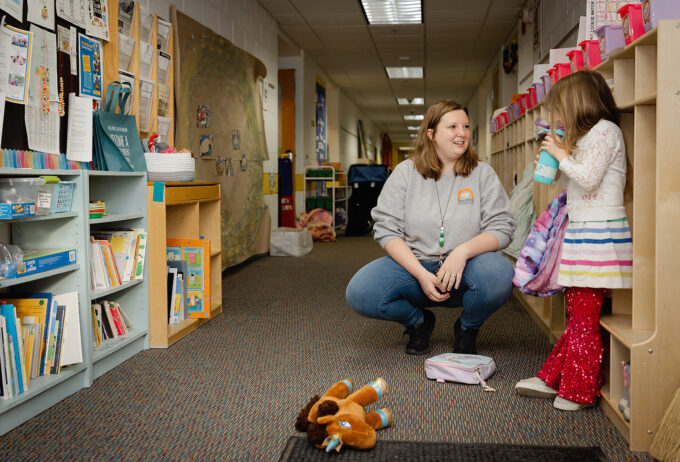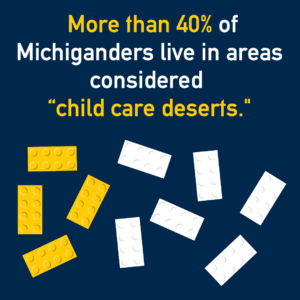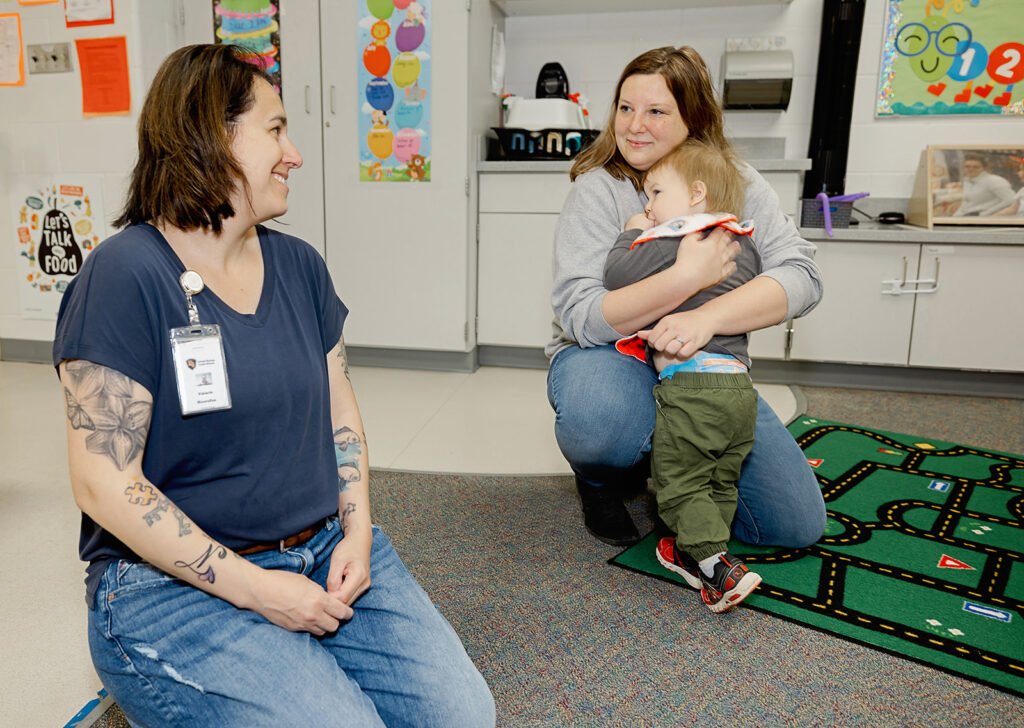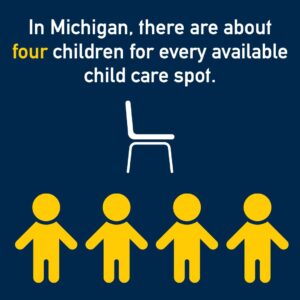Child care workers caught in middle of Michigan’s broken child care system

Sadie Riley-Flemming, director of Blackbird Child Care Center in Harbor Springs, greets a girl on April 19, 2024. Photos by Molly Hauxwell Currier for the University of Michigan.
By Lauren Slagter
U-M Poverty Solutions
A teacher has a question, notes for families await delivery to classrooms, and a little girl arriving at Blackbird Child Care Center in Harbor Springs needs her rain boots swapped for shoes.
Sadie Riley-Flemming responds to it all with a smile.
“Are you leaving your unicorn in your cubby or are you taking it to your classroom?” Riley-Flemming asks the girl, kneeling beside her in the hallway lined with colorful kids’ artwork. “You can’t forget your water bottle. Let’s grab your lunch box.”
Riley-Flemming walks the girl down the hall and continues her morning rounds, popping between classrooms for infants up to 12 year olds. A cuddly toddler’s drool soaks into Riley-Flemming’s gray Blackbird sweatshirt as she greets kids with hugs and plays with them briefly while asking their teachers if they need anything. In one room, Riley-Flemming’s son offers her a tray of plastic food.
“Mommy, I got all the food on there for you,” he says.
All morning, Riley-Flemming shifts between her role as a mother to two kids under 5, director of Blackbird Child Care Center, and frontline child care worker. She has a unique vantage point on Michigan’s child care industry – and lately she finds it “overwhelming and heartbreaking.”
“I could cry right now because it’s so tough,” says Riley-Flemming, 26, who has eight years of experience working in child care. “How can we provide families with affordable, quality child care without breaking their bank, but also give our employees a living wage? There’s just so many aspects of it. And there’s not a good answer right now.”
That gap Riley-Flemming identifies between what parents can afford to pay and the cost of quality child care is one of the key drivers of Michigan’s undersized child care workforce and shortage of available child care, according to research from North Central Michigan College’s Child Care Initiative and the University of Michigan’s Poverty Solutions.

Sadie Riley-Flemming plays with kids at Blackbird Child Care Center in Harbor Springs on April 19, 2024.
Statewide, there are about four children under 12 for every available child care spot. A couple making Michigan’s median income will spend about 14% of their income on center-based care for an infant – double the 7% of household income considered affordable for child care by the U.S. Department of Health and Human Services.
NCMC’s Child Care Initiative began working with Poverty Solutions in 2021 to better understand child care needs in Emmet County, located along the Lake Michigan shoreline at the northern tip of Michigan’s mitten. Historically, child care has been an undervalued industry, but the pandemic – with its temporary closures of child care facilities – made clear just how essential these workers are. With the workforce still in flux post-pandemic, Michigan misses out on $2.88 billion annually in economic activity when working parents struggle to find child care, according to a report from the Michigan Chamber of Commerce.
“Families and employers rely on child care providers to make our workforce work, so we need to solve this puzzle of how to sustainably fund quality child care,” said Jennifer Wixson, coordinator of early childhood education at NCMC.
Jennifer Wixson
As child care providers, parents, policymakers, and researchers wrestle with how to address Michigan’s child care shortage and make the business model work, Riley-Flemming sees child care workers – many of whom are parents too – getting caught in the middle.
Child care often takes up a large portion of a parent’s earnings, Riley-Flemming noted, even if child care workers get discounted tuition for their kids’ care.
“Then they’re also still not being paid a livable wage,” she said. “So they’re stuck in this middle ground where they might love working in the field, but they’re not really getting ahead, are they?”
High tuition, low worker pay

View of Little Traverse Bay from Harbor Springs. Photo by Lauren Slagter
Blackbird Child Care Center occupies one wing of Blackbird Elementary School, a brick building tucked in the trees half a mile from Harbor Springs’ panoramic views of Little Traverse Bay. Multi-million-dollar houses perch on the bluff overlooking the downtown district that serves tourists as well as the 1,270 residents that make up the close-knit community.
Across the bay from Harbor Springs sits Petoskey, a city of 5,670 people that is the metropolitan center of rural Emmet County. Like other tourist destinations, Petoskey is torn between catering to vacationers seeking second homes with bay views and remaining affordable for hospitality, retail, and health care workers who make the community run. For those workers to work, they need child care.
Blackbird is one of the more expensive child care centers in the area, Riley-Flemming said, as well as one of the higher-paying for employees. The pay still isn’t enough for workers to comfortably afford the local cost of living.
Most of the Emmet County child care employees surveyed by NCMC’s Child Care Initiative said they earn less than $50,000 a year, and pay for assistant teachers starts at $13 per hour. Across the state, early childhood educators earn 21.5% less than colleagues in the K-8 system and are 7.3 times more likely to live in poverty than Michigan K-8 teachers.
“I feel like the child care teachers who are here deserve a lot more than what they get,” said Riley-Flemming, who has been director of Blackbird Child Care Center since 2021. “And it’s been a challenge trying to find a way to give them what they deserve and continue to be operational financially.”

Teacher bios and notes of appreciation hang in the hallway at Blackbird Child Care Center in Harbor Springs.
Market demand would justify raising child care rates. With a shortage of available child care workers, more than 40% of Michiganders live in areas considered “child care deserts,” and the areas with the least child care availability are often rural and concentrated in northern Michigan. Blackbird closed its waitlist after it reached 240 kids, and Riley-Flemming said other local child care providers also have waitlists.

About 9% of Emmet County’s 34,100 residents live in poverty, compared to 13.4% of all Michigan residents. While Emmet County’s poverty rate is lower than the state overall, Riley-Flemming said many of the 136 kids at Blackbird Child Care Center are from working-class families from Petoskey, Harbor Springs, and the nearby village of Alanson. Raising tuition would only price them out.
Even with the discounted tuition she receives for working at Blackbird, Riley-Flemming and her husband, who works as a carpenter, can barely afford to send their two children there. To help lower costs, Riley-Flemming’s mother watches the kids one day a week. In months when money is tight, Riley-Flemming asks family members to take the kids more often.
“It’s a financial pressure to have them (in child care) more days a week,” Riley-Flemming said.
The average cost for infant care in a licensed child care center in Michigan is $13,620 annually. Regulations requiring small ratios of children to staff ensure kids have adequate supervision and also raise the cost of doing business.

William Lopez
In order for a family to spend no more than 7% of their income on child care while enrolling one infant in full-time care, their annual income would need to be $194,571. Michigan’s median household income is $68,505.
“The relationships between child care, income, and well-being are well documented in research and felt every day in households throughout Michigan. Parents need reliable, safe child care to be able to work consistently and provide financial stability to their families. Inconsistent child care – which can result in inconsistent work or job loss – can make it difficulty to buy groceries, pay rent, or afford the everyday household needs,” said William Lopez, a clinical assistant of public health at U-M and special advisor at U-M’s Poverty Solutions, who has studied child care needs across Michigan.
A call for more public investment in child care
Riley-Flemming has tried everything she can think of to make the math work for her child care center and the families it serves, including her own. She has applied for grants, worked with local organizations to fund tuition scholarships, and offered employees flexible scheduling to give them better work-life balance in lieu of higher pay. Frequent scheduling changes mean Riley-Flemming and Blackbird’s assistant director often cover classroom shifts, which draws them away from their administrative duties.
None of Riley-Flemming’s efforts have generated the revenue needed to adequately pay child care workers while keeping quality care affordable for families. The answer, she suggested, requires effort at the governmental level.
“Schools are subsidized. That’s (public) education. Early childhood programs are also education. So I feel like it’s not a far stretch to say that the government should also look into supporting child care programs,” Riley-Flemming said.

Sadie Riley-Flemming (right) talks with a staff member at Blackbird Child Care Center in Harbor Springs on April 19, 2024.
Federal and state funds support the Great Start Readiness Program, Head Start, and Early Head Start, which offer free child care and preschool for 3 and 4 year olds from families with low incomes. However, these programs are oversubscribed and not available in every community. Gov. Gretchen Whitmer has set a goal of providing free pre-Kindergarten for every 4 year old by 2027. While a necessary first step, even universal preschool would leave working parents in need of child care for their younger kids and for older kids outside of school hours.
Michigan’s Child Development and Care (CDC) subsidy promises more flexibility in helping families pay for child care, while reliably delivering payments to child care providers. In 2022, Michigan expanded the income eligibility for CDC subsidies, making up to 105,000 additional children eligible for the subsidy. However, only about 10% of children aged 0 to 11 years in households with incomes below the new eligibility threshold receive the subsidies.
“The low utilization rate of the Child Development and Care subsidy raises questions about barriers to accessing it and whether it’s meeting families’ needs when they receive it,” said Karen Ann Kling, assistant director of policy and impact at U-M’s Poverty Solutions.
Karen Kling
Kling co-authored a policy brief on challenges and opportunities related to the CDC subsidy, drawing from interviews with 41 parents of young children and child care professionals in southeast Michigan and Emmet County.
The interviews revealed numerous reasons parents do not apply for the child care subsidy: extensive paperwork requirements, language barriers, distrust of the government, and a reliance on internet-based applications. There’s also the “catch-22” that people need employment to qualify for the CDC subsidy, but it’s difficult for parents to find employment without child care.
 Parents who do receive the subsidy then have to find a child care provider approved to accept subsidies that has space for the child and offers care in a location and at hours that work for the family – no easy task with four young kids for every available child care spot in Michigan. This combination of barriers explains why Michigan’s child care subsidies are underutilized, Kling said.
Parents who do receive the subsidy then have to find a child care provider approved to accept subsidies that has space for the child and offers care in a location and at hours that work for the family – no easy task with four young kids for every available child care spot in Michigan. This combination of barriers explains why Michigan’s child care subsidies are underutilized, Kling said.
Riley-Flemming also has seen various factors prevent families from using the child care subsidy. She recalled one parent who lost her other public benefits after being approved for the CDC subsidy because of an administrative error in the application process. Another parent declined to apply for the subsidy because she didn’t want to give her children more vaccines to meet state regulations, Riley-Flemming said, and didn’t know there’s an option to submit a vaccine waiver. Blackbird employees with kids at the center could not receive the subsidy if they worked in the same classroom where their kids spent the day.
Still, Blackbird has a handful of families who use the child care subsidy, and Riley-Flemming said it’s a fairly easy process to accept the payments every month. And it isn’t only families that benefit from the subsidy. Riley-Flemming finds the subsidy payments are a more reliable source of revenue than income from families struggling to make payments.
Rethinking Michigan’s child care subsidy system
For Michigan’s child care subsidy to realize its goal of providing access to affordable, high-quality child care, Riley-Flemming would like to see the state raise the income cutoff. Currently, households making 200% of the federal poverty line or less are eligible for the subsidy, which equates to $51,640 a year for a family of three in 2024.
The Tri-Share program – which splits the cost of child care among the parent, their employer, and the state – is available to people who make too much to qualify for the subsidy, up to 325% of the federal poverty line. Employers benefit when their employees can focus on work without child care concerns, and having employers contribute to child care costs eases the burden on families and limited government funds. The Tri-Share website lists only 186 participating employers across the state.

Sadie Riley-Flemming leads kids down the hall at Blackbird Child Care Center in Harbor Springs on April 19, 2024.
“I think our working-class families are at a large disadvantage where they can’t get ahead,” Riley-Flemming said. “We all want what’s best for the kids and the families and that’s to move forward with life and not be so stuck or living paycheck-to-paycheck. I think lifting that threshold (for child care subsidies) will help a lot of families be more successful.”
But making more families eligible for assistance to pay for child care only helps if enough child care spots are available.
“Growing the child care workforce is an essential part of solving Michigan’s child care crisis. We need to address availability as well as cost,” said Amanda Nothaft, director of data and evaluation at U-M’s Poverty Solutions, who co-authored the child care subsidy policy brief with Kling and Lopez.
Amanda Nothaft
Researchers at U-M’s Poverty Solutions also recommend reducing the amount of paperwork needed to apply for and maintain the child care subsidy, for both parents and child care providers. To help answer child care providers’ frequently asked questions about the CDC subsidy, Poverty Solutions worked with the Michigan Department of Health and Human Services in 2022 to create a website with clear information on the steps needed to accept the subsidy.
NCMC’s Child Care Initiative is testing a “true cost” model in an Emmet County child care business that will include standard costs such as licensing, facilities, and non-personnel items as well as living wages and benefits for all staff and owners, plus the cost of quality programming, professional development, and employee wage increases.
“Charging the true cost of child care makes the child care industry sustainable in the long run and will grow the supply of child care in our area,” Wixson said. “As part of the true cost model, we’re also working to secure various public and private funding streams, so we have a blueprint for how to cover the cost without pricing out families.”
In the meantime, Riley-Flemming feels stretched between wanting to do right by Blackbird families as well as employees. She tries to stay focused on the kids that fuel her passion for the work.
“Early childhood is the foundation to education,” Riley-Flemming said. “So you start building … that early learning to help children be more successful as they go through the school system. You invest in children, you’re investing in your future.”
Related
The Child Development and Care Subsidy: Challenges and Opportunities policy brief
North Central Michigan College Child Care Initiative
The Updated Michigan Child Development and Care Subsidy: What Child Care Providers Need to Know



